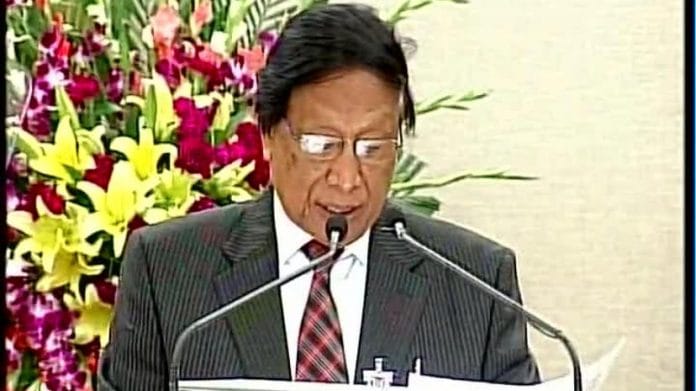Guwahati: Negotiations between the Modi government and Naga groups led by the National Socialist Council of Nagaland (Isak-Muivah) have intensified over the past month but there seems to be no agreement yet between the two sides on setting a deadline to clinch a final peace accord to end India’s oldest insurgency.
The new round of talks are being held in New Delhi amid the Covid-19 pandemic.
The Modi government, sources told ThePrint, is keen to seal a deal at the earliest. Although some news reports have claimed the government wants to sign the Naga accord by the end of this month, a senior NSCN (I-M) leader in Nagaland told ThePrint he was not aware of any such deadline.
“The important thing is whether we have understood each other and agree together. I don’t think there is any time limit set by the Government of India, and there should be no deadline again,” senior NSCN (I-M) leader and deputy kilonser (home minister) Kehoi told ThePrint.
However, another senior leader of one of the NSCN factions and a member of the Naga National Political Groups (NNPG), who spoke on the condition of anonymity, said, “Though there is no deadline announced, I have a feeling it is going to be over by October.”
The NNPGs are a group of seven Naga insurgent outfits that are also holding talks with the central government.
It was after the conclusion of the peace talks on 31 October last year that the government had issued a statement saying any settlement with the Naga groups would be reached only after consultations with all stakeholders, including the neighbouring states of Manipur, Assam and Arunachal Pradesh.
The government had earlier imposed this deadline to strike a deal with the NSCN (I-M), and Nagaland Governor R.N. Ravi had announced in July 2019 that Prime Minister Narendra Modi desired to conclude the talks within three months. At present, however, the Manipur and Arunachal governments have not been consulted yet.
It has been 23 years since talks between the NSCN (I-M) and the central government began in 1997.
In August 2015, the Modi government signed a Framework Agreement to seek a final solution with the NSCN (I-M). The NNPGs joined the talks later by signing a ‘Deed of Commitment’ with the government in 2017.
Also read: Modi govt could look beyond NSCN (I-M) for peace in Nagaland as new players emerge
NNPGs for ‘inclusive solution’
The working committee of the NNPGs now wants an “inclusive solution” that does not leave out anyone.
“We want an inclusive solution, but this is not in our hands alone,” the NSCN-Unification (NSCN-U) leader and coordinator of WC NNPGs, Alezo Venuh, told ThePrint.
“The I-M has been in negotiation for more than 23 years. We started only three years ago and have agreed in principle with the Centre on what is possible. What cannot be achieved now can be sorted out through a democratic political process,” he said, adding the NNPGs also want the Indian Nagas in Myanmar to join the peace process.
“We are not just negotiating for the Nagas of Nagaland. At this point of time, integration of Naga-inhabited areas is not going to happen,” Venuh added. “Assam is non-contiguous, but for Arunachal and Manipur — the other two neighbours — regional territorial councils have been worked out in consultation with the governments of both states.”
A meeting between the WC NNPGs and peace talks interlocutor Ravi was held in Dimapur on 10 September, with the NNPGs stating that “the Naga issue must be settled and the waiting period is over”.
Also read: PM Modi has now mandated IB to continue talks as Governor ‘created imbroglio’ — NSCN(I-M)
The Naga flag, Constitution and competencies
Both the central government and the NSCN (I-M) are sticking to their stand over the latter’s demand for a separate Naga flag and Constitution.
On 11 September, the NSCN (I-M) said in a press release that “there is no other way to go forward without the Naga flag”.
In October last year, 14 apex tribal Hohos and other civil society bodies had met Governor Ravi to request for an extension of the 31 October 2019 deadline so that various factions can get time to speak to the Naga people, and to ask the NSCN (I-M) for an explanation on the demands for a separate flag and constitution, along with the other ‘competency clauses’ of the Framework Agreement.
The NSCN (I-M) in its recent statement mentioned that some of the competencies are still being negotiated and “needs caution until its completion” before being made public.
Civil society groups want NSCN (I-M) & NNPGs on same page
The Naga Hoho, the apex body of the Naga tribes, has urged both the NNPGs and NSCN (I-M) to come together for “an early acceptable solution to the Naga problem”.
“We want all groups to sit together. In any case, Naga identity has to be protected. Unless all the points are agreed upon by all parties, there would be implications that would be too costly for everyone post-solution,” said K. Elu Ndang, general secretary, Naga Hoho.
“Both I-M and NNPGs might have one agenda, but there might be miscommunication if they don’t discuss it together. It has to be one agreement, one solution.”
“We had enough time to take the decision. Now every political group should come together in the same platform and mutually agree for a permanent solution,” said Aakam Pame, a social activist.
Also read: ‘Coordinated attempt to create confusion’ — full statement by NSCN(I-M) on Naga peace deal







Actually, all States and UTs must be allowed to have their own flag and protocols worked out about how to use and fly such flags. That will implement a true Federal model like the US.